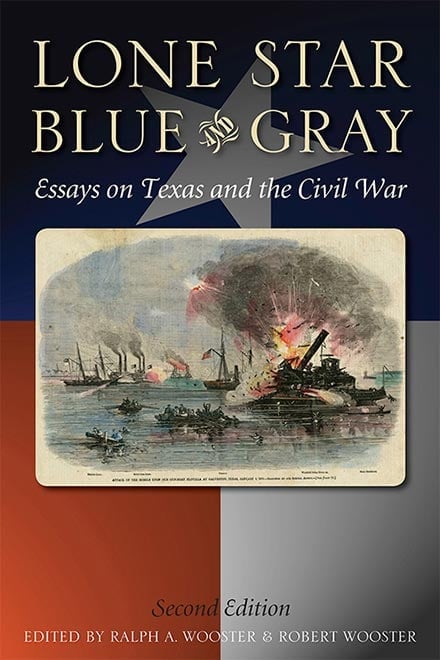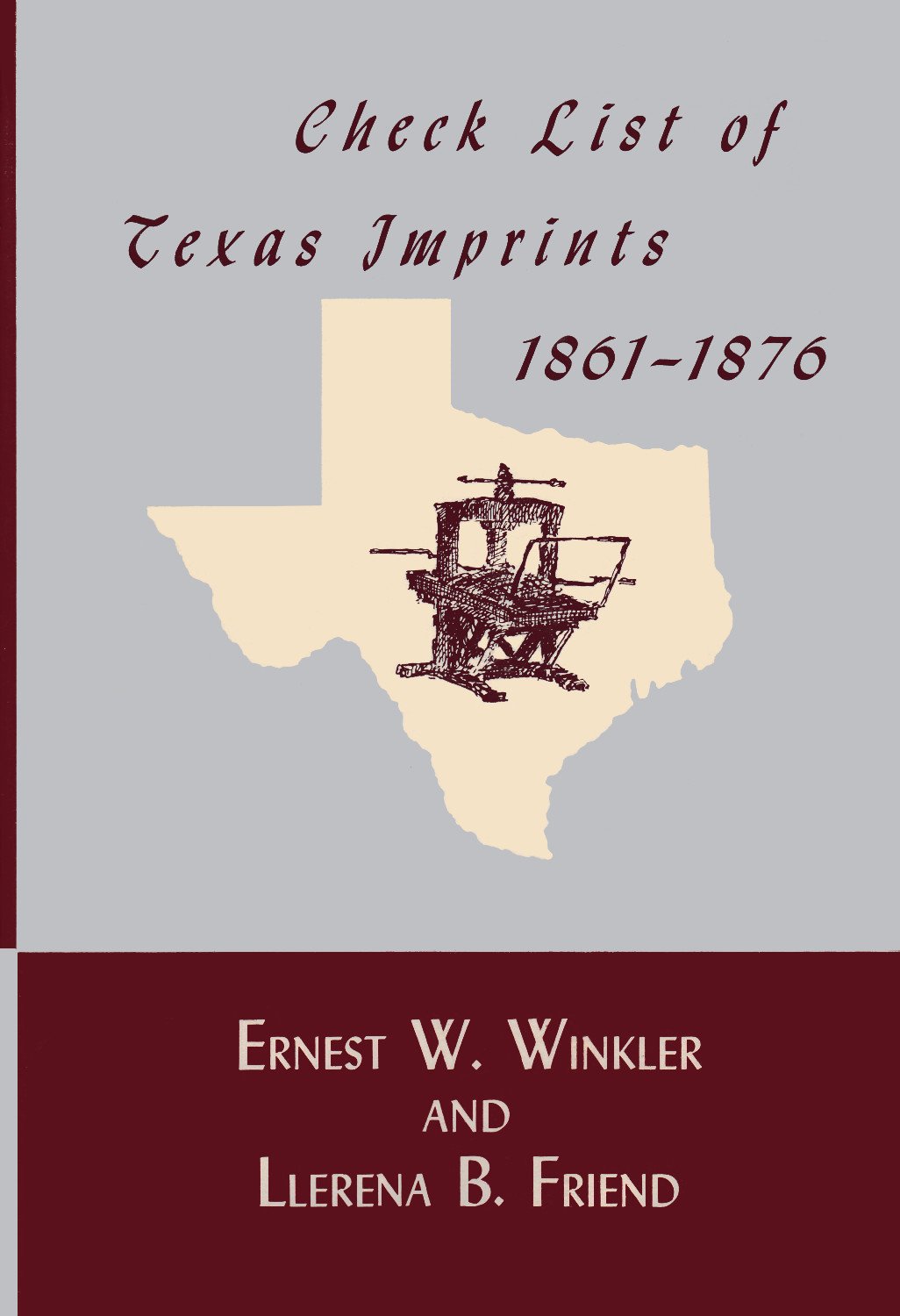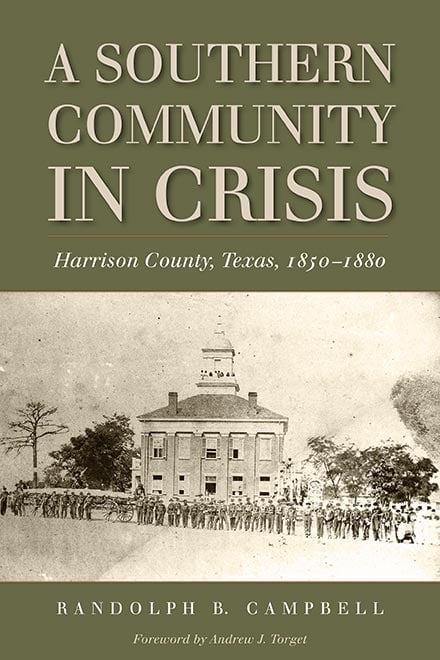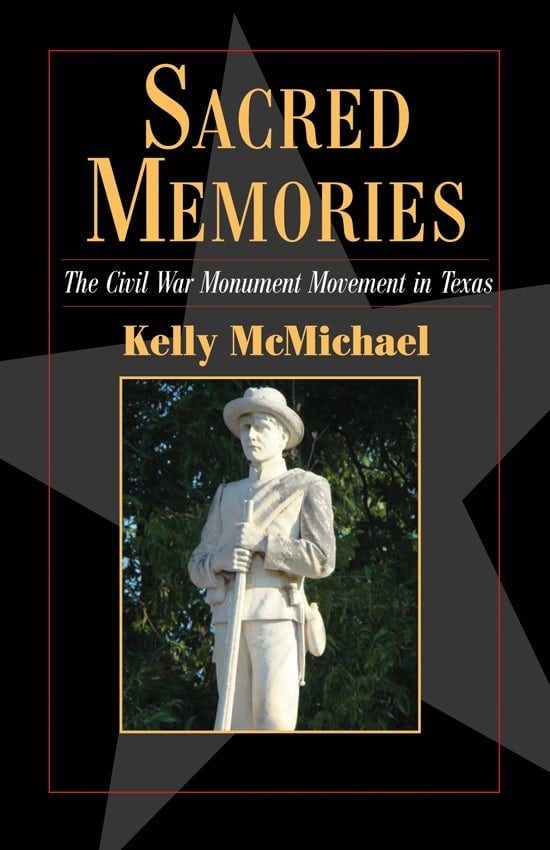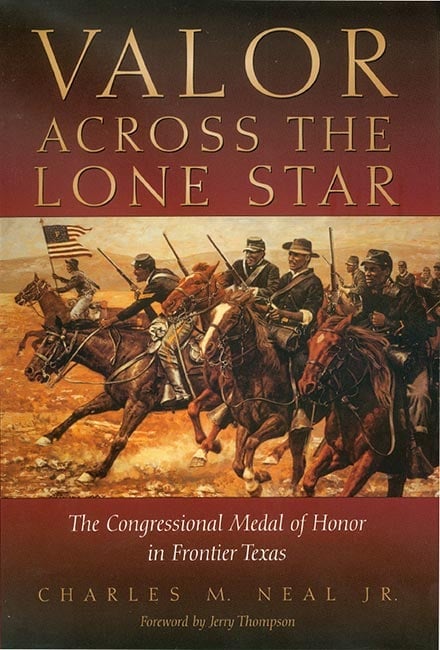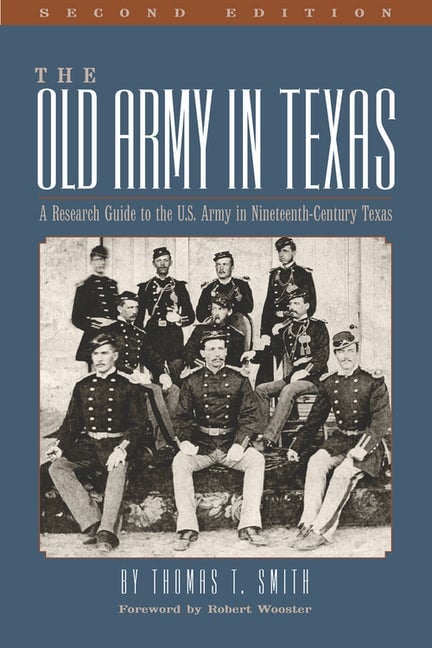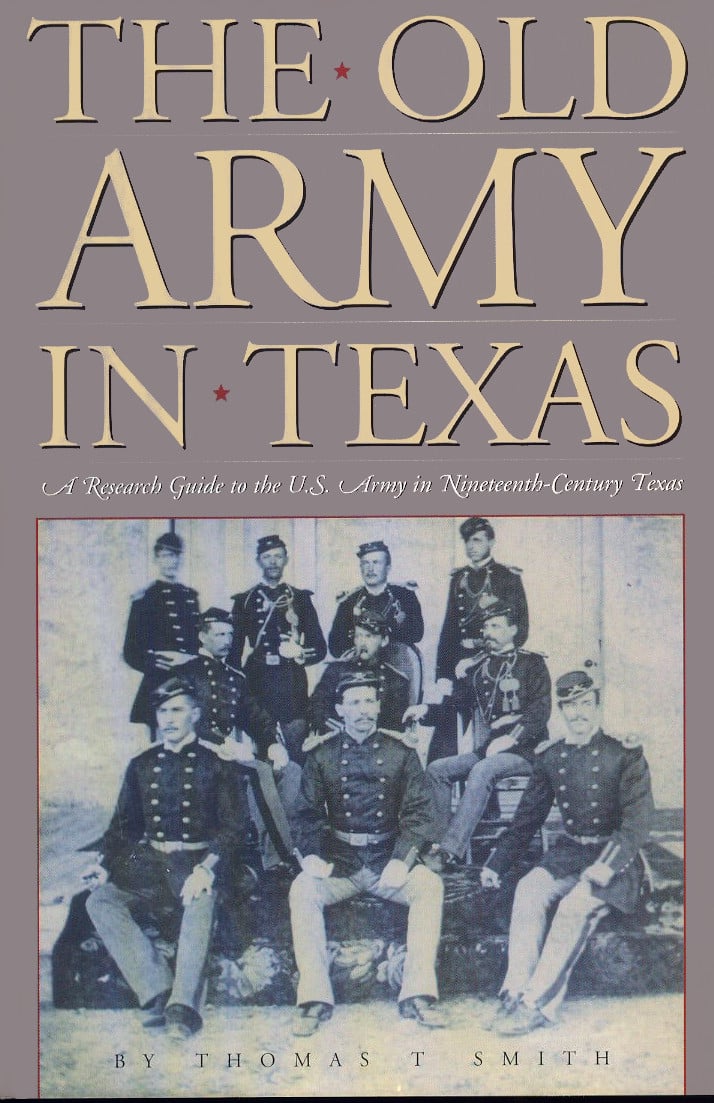For nine years following the Civil War, Texas was in turmoil, as its people attempted to solve political, social, and economic problems produced by the war. Emancipation changed the labor system, and the end of slavery forced a redefinition of the relationship between Blacks and Whites. The change in labor and the costs of the war threatened to undermine the economic power of those who had dominated antebellum economic life, which was focused on the plantation. The weakening of the antebellum elite threatened not only their economic and social position but also their political power. In 1865 Texans confronted a situation in which new directions could be taken in economic development, political alignments, and social order. The period of Reconstruction presented the old order with a critical challenge.
One of the major forces that threatened change in the state was the United States Army. Federal troops began entering the state in late May 1865. Their commanders believed that their duty, at least in part, was to ensure loyal government and to protect the rights of the Blacks who were free as a result of the war. Gen. George A. Custer, stationed at Austin, expressed the military view when he recommended that the army retain control of the state until the government was "satisfied that a loyal sentiment prevails in at least a majority of the inhabitants." The military insistence upon loyalty threatened an indefinite loss of power among antebellum and wartime political leaders. Military views regarding the freedmen posed, at least in the minds of White Texans, a permanent disruption of their labor system and, subsequently, their entire economy. Their fears proved groundless, at least for the most part, for a variety of factors prevented the army from effecting all the change of which it seemed capable. Rapid demobilization reduced within a year the number of troops in the state from 51,000 to 3,000, and many of those who remained were on the frontier. The small size of the occupying army thus guaranteed its ineffectiveness. Still, various military commanders attempted to intervene in local politics. Turnover among them, however, prevented the development of a sustained policy in Texas. From May 1865 to March 1870 the command of forces in the state changed eight times. Of the commanders, Charles Griffin was the most active politically, but his career ended with his death in September 1867. His successor, Joseph J. Reynolds, was also politically active, though changes in command over him and his own indecisiveness and incompetence frustrated his forays into local politics. Wavering but domineering army policies ultimately provoked the local White population into an obstinate defense of prewar political power and control over the Black population.
The formation of the Bureau of Refugees, Freedmen, and Abandoned Lands (the Freedmen's Bureau) presented a further threat to prewar society. This agency began its operations in the state in September 1865 under the command of Maj. Gen. Edgar M. Gregory. The bureau was charged with overseeing all matters concerning refugees, freedmen, and abandoned lands, but its principal role was helping the new freedmen make the transition from slavery to freedom. Gregory, an abolitionist, interpreted his chief goal in the state as establishing a free labor system for the former slaves. Despite White fears, the course of Gregory and his principal successors, Joseph B. Kiddoo, Charles Griffin, and Joseph J. Reynolds, proved very conservative. Within a year Gregory's labor policies forced Blacks back to work on the state's farms and plantations, often where they had lived as slaves. He pressured them not only to stay where they were but to sign contracts to work for wages or on shares. With no ability to acquire land on their own, most complied. While planters complained publicly that free Black labor was not as good as slave, in private most found the new situation of tenantry acceptable. The indebtedness of tenants to landlords contained its own mechanisms for controlling the freedom of the labor force and pushed laborers into a form of debt peonage. Though the workers possessed freedom to search for the best conditions among local landowners, they had few choices other than to labor on some other person's land. Other aspects of the bureau's work were not as acceptable to Whites. They saw attempts to educate the freedmen as potentially destructive to good order, although education in fact would have deprived planters of their workers by opening up new opportunities for them. They also criticized the intervention of agents and bureau courts in situations where bureau agents charged that Blacks were being treated unjustly. The bureau adjudicated matters ranging from violence to adherence to labor contracts. However, the challenge represented by bureau schools and courts was always more in appearance than reality. The schools did not receive the financial support necessary to serve the large Black population. The courts were inadequate for the protection of the freedmen and irritated the Whites brought before them. The bureau had little effect and, like the army, served to provoke Whites to even greater opposition.
Free Blacks provided a third challenge to the antebellum status quo, despite the limits imposed on their full freedom by the military, the bureau, and their peculiar economic conditions. Blacks from the war's end demonstrated their hopes that they could secure control over every aspect of their lives, including their labor, their families, and their social institutions. Further, they desired education and found support for that aspiration in the bureau's schools. In pressing for these elements of full freedom they encountered opposition from Whites who saw these goals as a threat to their own control over their labor force as well as their social position. In their efforts to maintain control over Blacks, Whites resorted to fraud against their workers, economic intimidation, and even violence. This White response prompted Blacks to demand protection in the law in order to guarantee their freedom. In the end, they also concluded that only through gaining the vote themselves could their freedom be assured. Their hopes were manifest publicly for one of the first times on March 10, 1866, when a group of freedmen gathered in Austin to address their concerns. In the meeting, delegates discussed demanding their right of suffrage and called upon the state government to assure that they would derive benefits from the state's public school lands. The March meeting led to the creation of the Austin Freedmen's Society whose members ultimately were among the founding Black members of the state's Republican party.
Presidential Reconstruction presented a fourth threat to antebellum order. Under this plan for restoring the South to the Union, the president was to appoint a provisional governor for each state. The provisional governor was required to call a convention in order to nullify the act of secession, to abolish slavery, and to repudiate the state's Confederate debt. The delegates to the convention had to take an oath of amnesty as prescribed by the president and were to be elected by voters who had also taken the oath. Once the voters had ratified the work of the convention, they would elect a governor, a legislature, and other state officials. When the legislature had ratified the Thirteenth Amendment of the United States Constitution, the state would be fully restored to the Union. In accordance with this plan, President Andrew Johnson appointed Andrew J. Hamilton provisional governor of Texas. Hamilton represented elements of the antebellum opposition to the dominant Democratic party and received a great deal of support from Texas Unionists. Many of these Unionists had not only opposed secession but subsequently continued to support the Union, many fleeing the state during the war. Some, such as Judge Edmund J. Davis, actually joined the Union Army. The requirement of the oath of amnesty was designed to exclude much of the antebellum political leadership from the convention and allow the Unionists to rise to power in its place. The success of this party would mean a different distribution of the resources of state government and the acceptance of a broader definition of freedmen's rights than many of the old order were willing to permit. In fact, Hamilton failed to prevent the resurgence of the Democrats. In the election held on January 8, 1866, the prewar power structure reasserted itself. This was made possible by the fact that although this group had suffered economically, their losses were only relative. The war had not driven them from their control of the state's economic life. They now demanded political power again, and, even though excluded by the provisions of Presidential Reconstruction, many voted and ran for the convention. When the delegates assembled at Austin in February 1866 they included a large number of prominent prewar and Confederate leaders, including Hardin Richard Runnels, Oran M. Roberts, R. S. Walker, and T. N. Waul. They made some concessions to the Reconstruction situation, however, and in the Constitutional Convention of 1866 they shared power with moderate Unionists, those who were willing to make concessions to the Democrats. Members of the coalition called themselves conservatives, and they elected James W. Throckmorton, a Unionist from northeastern Texas, as president of the convention.
The proceedings of the convention showed the reluctance of the White majority to meet anything more than the president's minimum requirements for readmission to regular status in the Union. The delegates renounced the right of secession and proclaimed the state's act of secession null and void; Unionist delegates attempted unsuccessfully to have secession declared null and void ab initio-from the beginning (see AB INITIO QUESTION). The delegates also declared their acceptance of the abolition of slavery and granted Blacks basic rights, but did not concede Black suffrage. They repudiated the state's war debt. Finally, in an action that fueled controversy through the rest of Reconstruction, they validated all laws of the state government during the war that were not in conflict with the United States Constitution, the state constitution prior to secession, or proclamations of the provisional governor. They set an election of ratification, at which officials were also elected, for June 25, 1866, and the proposed constitution passed. Voters also had to select state officers and choose between a conservative ticket, headed by Throckmorton, and a Unionist one, led by former governor Elisha M. Pease. The campaign centered on charges that Pease represented the interests of radical Republicans in the North and supported extension of suffrage to the freedmen. The power of antebellum politicians again asserted itself when Throckmorton handily carried the election by a vote of 49,277 to 12,168.
The Eleventh Texas Legislature met on August 6, 1866, and Throckmorton took office six days later. The governor's efforts at securing recognition were hindered by the many former secessionists who dominated the legislature. These men selected two prominent secessionists, O. M. Roberts and David G. Burnet, for seats in the United States Senate. The legislature's actions attempted to return the state as much as possible to the status quo ante bellum. They refused to ratify the Thirteenth and Fourteenth amendments. The members also enacted "Black Codes," a series of measures designed to regulate Black labor through apprenticeship, contract labor, and vagrancy laws. These labor laws appeared to Unionists in Texas and Republicans in the North to be an attempt to establish a new form of slavery. Such activity convinced even those Unionists who had not remained outside the conservative coalition that the former Confederates were back in control and unrepentant. It raised similar doubts in the minds of the local military commanders, the assistant commissioner of the Freedmen's Bureau, and the members of Congress. Neither the senators chosen by the legislature nor the congressmen elected by Texas voters were allowed to take their seats in Washington. Throckmorton himself increased tension by his complaints against the army for interfering in civil affairs and in his efforts to protect the frontier from Indian raids by fielding ranging companies. Throckmorton believed that the army and the Freedmen's Bureau meddled unreasonably in civil affairs and that the army was not doing its duty on the frontier. In turn, military officials and Unionists believed that Throckmorton, relying on local justice, had brought about a situation in which die-hard Confederates persecuted and even murdered Blacks and Unionists without punishment. They also feared that the governor's rangers were intended as a political organization to block Reconstruction as much as to fight Indians.
Congress brought the course of Throckmorton, the legislature, and Presidential Reconstruction to an end on March 2, 1867, with its First Reconstruction Act. The law broke the South into military districts under the command of the army and declared the existing governments to be provisional. Texas was placed in the Fifth Military District. From the beginning General Griffin, commander in Texas, differed from Throckmorton on policy, and on July 30, 1867, at the request of Griffin, Gen. Philip H. Sheridan, commander of the district, removed Throckmorton from office as an "impediment to Reconstruction." In his complaints to Sheridan, Griffin cited Throckmorton's failure to qualify for office under the "military bill" (the First Reconstruction Act) and his refusal to cooperate in the punishment of those who had committed outrages against loyal men, White and Black. Following Throckmorton's removal, complaints from Unionists, Blacks, and Freedmen's Bureau officials about local officials who refused to protect their lives and property continued to pour into military headquarters. Griffin began to move toward removing these local officials, but little was done toward this end before his death in the yellow fever epidemic that swept through the eastern portions of the state that summer and fall. His successor, Joseph J. Reynolds, continued to receive complaints, and with a series of special orders began wholesale removals in the fall of 1867. The most sweeping of these special orders, No. 195, issued on November 1, 1867, removed more than 400 county officials in fifty-seven counties across the state. Four days later Reynolds removed the elected city officials of San Antonio, and the day after that, their terms having expired, he replaced the officials of Austin. The men Reynolds appointed to replace these removed officials had to be capable of taking the "Test Oath," passed by Congress on July 2, 1862, stating that they had never voluntarily borne arms against the United States or given "aid, countenance, counsel, or encouragement to persons engaged in armed hostility thereto." The removals continued until most counties in the state had had at least one county official removed. Many local elected officials who remained in office after Reynolds's removals of late 1867 and early 1868 were forced to leave office in April 1869, when Gen. Edward R. S. Canby ruled that every office filled by an elected official incapable of taking the Test Oath would be considered vacant on April 25, 1869.
Under the provisions of Congressional Reconstruction, Texans had to take new steps for restoration. The state had to have another constitutional convention, with delegates elected by all male citizens over the age of twenty-one, regardless of race, color, or "previous condition of servitude." Only felons and those who had been disfranchised for their part in the rebellion could not participate. Congress required that the convention write a new state constitution that would provide for universal adult male suffrage. When the constitution had been written and the state had ratified the Fourteenth Amendment of the United States Constitution, Congress would consider the case for readmission to the Union. In the spring and summer of 1867 political parties organized in preparation for the new constitutional convention.
Unionists' active participation in forming the state's Republican party linked them with Black voters, who would for the first time be allowed to take part in the political process. The biracial nature of the party led its opponents to refer to it usually as the Radical party. In fact, like the Unionists, the men who joined the new party represented diverse interests. Regional concerns, economic interests, race, and ideological considerations provided the motivating force behind those who joined this party. Blacks organized under White sponsorship in the Union League, an organization that its opponents charged manipulated Black voters through its secret rituals. Of course, by the spring of 1867 Blacks had already mobilized to demand that politicians address their concerns, including granting the suffrage. Their support of the Republican party and the Union League reflected the fact that these organizations reflected their concerns and hopes. Despite the varied interests of the individuals who joined the new party, Black and White, their opposition to the power and policies of the conservatives held them together.
This combination of White and Black voters promised an electoral triumph and a potential political revolution. Those opposed to the coming convention were not sure exactly how to respond. Their leaders at first encouraged voters to stay away from the polls and ensure that the convention did not receive a majority of votes. On January 20, 1868, conservatives met at Houston and concluded that their supporters should vote against a convention and for conservative delegates, stating that they preferred military rule to the "Africanization" that would result from a convention. The result was that most conservatives did not bother to register or to vote. The radicals carried the election by a vote of 44,689 to 11,440. The turnout indicated that most White Texans either did not believe they had a real say in the election, or they did not care. Contrary to the traditional argument that they had been disfranchised, most registered to vote, but only a little more than half of the registered Whites actually cast ballots.
The convention met at Austin on June 1, 1868, and did not adjourn until February 1869. Though the delegates devoted as much time to special-interest legislation as to drafting the basic document, the constitution they wrote differed significantly from previous constitutions. It authorized a more centralized and bureaucratized system of government, with greater power in the hands of the governor, who received extensive powers of appointment, including the right to name district judges. The centralizing tendencies of the constitution later proved to be controversial, but in the convention this strengthening of executive power was one of the few issues that did not produce conflict between Democratic and Republican delegates. No matter what the strengths or weaknesses of the proposed constitution were, its drafting produced political turmoil. The assembly uncovered major weaknesses within the new Republican party. After disagreeing over many measures in the constitutional convention, the party split over the same issues at their convention in August 1868. A. J. Hamilton and E. M. Pease led what came to be known as the moderate wing of the party. Edmund J. Davis, James P. Newcomb, and Morgan C. Hamilton dominated the radical wing. The terms moderate and radical referred primarily to the parties' willingness to grant rights to Blacks or to make concessions to former Confederates, but the split also reflected differences over economic and other policies as well. The radical Republicans successfully incorporated much of their program into the proposed constitution, including state recognition of the equality of all persons before the law, ensuring Black manhood suffrage, providing for a system of public education, encouraging immigration, and even allowing state support for economic development, although prohibiting the granting of state lands to achieve that end. One radical delegate even proposed expansion of the definition of basic civil rights to include extending suffrage to women, a measure supported by Martha Tunstall and the Austin Friends of Female Suffrage. The majority of male delegates, however, refused to incorporate woman suffrage into the proposed constitution. The moderates, however, managed to include in the document liberal provisions restoring the franchise to former Confederates. This particular concession caused the radicals to oppose, at Washington, the holding of an election to ratify the proposed constitution. The moderates, however, urged the Ulysses Grant administration to accept the document. When it became clear that the Grant administration would hold an election for ratification and for state offices, the two factions each put candidates in the field.
Texans began preparing for an election in the spring of 1869, though the election was not held until the following December. The two Republican factions ran opposing tickets. The radicals selected the man who had led them in the convention, Edmund J. Davis, and the moderates chose A. J. Hamilton. Hamilton actively pursued support among the former Democratic leadership in the subsequent campaign. The two factions actively jockeyed for support from the administration of President Ulysses S. Grant, support that ultimately went to the Davis faction, which received federal patronage after September 1869. Grant's support helped Davis to get the Black vote. On January 11, 1870, General Reynolds declared that the new constitution had been ratified and that Edmund J. Davis had received an 800-vote majority. Hamilton Stuart, a newspaper editor, received 380 votes. On February 8, 1870, the elected members of the Twelfth legislature assembled at Austin at the order of the military commander. They were to adopt the Fourteenth and Fifteenth amendments and select United States senators in preparation for readmission to the Union. They quickly approved the amendments and selected Morgan C. Hamilton for a six-year term and James W. Flanagan for a four-year term. This completed the requirements set by Congress for readmission. On March 30, 1870, President Grant signed the act that readmitted Texas to the Union and ended Congressional Reconstruction. On April 26, 1870, the Twelfth legislature reconvened in a special session and initiated a program that addressed the numerous problems that had emerged since the war and that reflected the goals of the radical Republicans. As a whole, the program produced a significant increase in the role of state government. It also demonstrated Republican commitment to change.
Of the issues addressed, none provided more controversy than that of violence. Everyone agreed that lawlessness was rampant in much of the state, but parties could not agree about the cause. Certainly much of it could be attributed to the postwar breakup. Bands of brigands roamed along the Red River and in the Big Thicket country. Gangs led by such outlaws as Cullen M. Baker, Benjamin F. Bickerstaff, and Bob Lee preyed upon the people of northeastern Texas. Though their targets often were freedmen or federal soldiers, these murderers and horse thieves could hardly be called political activists. Postwar violence also had increased along the Mexican border and was usually associated with cattle and horse theft but also involved efforts by Anglos to drive Tejanos from their lands. On the other hand, much of the period's violence clearly had racial or political overtones, with perpetrators either intimidating Black workers or suppressing Black political activity. The Convention of 1868 reported that of 939 murders in the state between 1865 and 1868, 379 were murders of Blacks committed by Whites. In 1868 General Reynolds also reported that armed organizations, generally known as the Ku Klux Klan but locally referred to as Pale Face, Knights of the White Camellia, or the White Brotherhood, were operating in areas east of the Trinity River. In fact the Klan also appeared in the Black belt plantation counties along the lower Brazos, Colorado, and Trinity rivers. Their targets were Blacks and Union men. Although no evidence exists to prove a statewide organization, such groups clearly were political in motivation. As its chief measure to end this lawlessness, the legislature passed a state police bill and established a militia, which had among its responsibilities the support of the state police. Both forces were placed under the adjutant general for coordination. To aid the police the legislature also expanded the district court system. Although controversy surrounded these measures from the beginning, the program appeared to achieve its goals. In 1871 the police made 3,602 arrests, and in 1872 the adjutant general reported 1,204 arrests. In its first three years of existence the police force recovered $200,000 in stolen property. Many of the state's citizens began to look to the force for protection. In addition, despite some early fears, the militia was used sparingly. Still, the police measures produced many enemies. Local citizens complained that police behavior was inappropriate. The use of the police to protect pools of voters during elections incensed the Republicans' opponents, who charged that the force was only a political organization. The fact that many of the policemen were Blacks and had authority over Whites did not help the reputation of the police. When Governor Davis used the militia, again composed frequently of Blacks, to enforce order at the polls, that organization was also linked inextricably to the Republican regime. Declarations of martial law and the use of the militia in Madison, Hill, Walker, Limestone, and Freestone counties produced widespread condemnation. When adjutant general James Davidson fled the state in 1872, with $34,434.67 of state money, he added to the darkened reputation of the police.
Almost as controversial were the Davis government's school measures. The legislature did not produce a successful school law until 1871, and this act inaugurated a highly centralized system of public schools. The state supported the schools in each county, making free public education possible for the first time; selected and tested the teachers; determined a common curriculum; and provided for a graded system of three classes—primary, elementary, and advanced. The schools were segregated, despite the objections of Black political leaders like George Thompson Ruby and Matthew Gaines. Efforts at creating different schools for boys and girls, however, were defeated. The public education system, headed by Jacob C. DeGress, grew rapidly. Enrollment peaked at 129,542, or 56 percent of the scholastic population, in 1872–73. But opponents raised objections to the education of Blacks, compulsory attendance, centralization of authority, and costs. Costs were particularly high with the system committed to different schools for Blacks and Whites. The cost of the schools generated enough enemies that they provided a major focus of Democratic attacks on the Republican program. Other laws also provided a basis for criticism. Opponents condemned the law that set the first state election to be held after readmission in November 1872, rather than in November 1871. This law gave the legislature a two-year term, as provided in the Constitution, but changed the election date set by the Constitution. An enabling act allowing the governor to appoint district attorneys, county treasurers and surveyors, cattle and hide inspectors, public cotton weighers, and mayors and aldermen, and to fill other vacancies until regularly-scheduled elections was considered another dangerous appropriation of power.
Republican aid to railroads produced less party strife and indicated the Republicans' belief in the need to encourage economic development, although backers of Governor Davis attempted unsuccessfully to limit state subsidies to only a single road that would tie Texas to northeastern markets. The first major act was the legislature's incorporation of the International Railroad Company, which received $10,000, in 8 percent bonds, for each mile of new road. In a later session the legislature gave subsidies to the Southern Trans-Continental and the Southern Pacific. Governor Davis vetoed these bills, contending that the state could support only one railroad, but a coalition of Democrats and Republicans overrode his veto. The legislature also authorized counties and towns to provide their own support for railroads through the issuance of bonds. In addition to the railroad measures, other laws designed to promote growth passed with little debate. The legislature passed two homestead laws to encourage immigration and farm expansion. The first allowed 160 acres of state land to each head of a family who did not already possess a homestead. In turn the homesteader had to occupy the land for three years and pay processing fees. Single men were allowed eighty acres. The settler wishing less than 160 acres could buy land for a dollar an acre. The second law exempted from forced sale a family homestead of not more than 200 acres of rural land or more than $5,000 worth of city property. Efforts were also made to encourage cotton and woolen textile factories by granting such concerns tax exemptions for up to five years on their stock and property used in production. The legislature also founded a bureau, headed by Gustav Loeffler, to encourage immigration.
Another component of the Republican program that produced little debate was its Indian policy. The state government wanted to get rid of the Indians. A frontier protection bill provided for ranging companies of troops, although they were never funded sufficiently to have an effect. The Davis government's chief problem in Indian affairs was that the Republican federal government was trying to get Indians onto reservations, while most White Texans wanted them exterminated instead. The height of this conflict came in October 1873, when Davis was pressured by the federal government into releasing the Kiowa chiefs Satanta and Big Tree, who had been imprisoned for a raid on a wagon train near Jacksboro. Davis won few friends by giving in. In fact, however, neither the state nor federal government settled the situation on the frontier until more aggressive tactics were introduced by Gen. Ranald S. Mackenzie in 1874. His defeat of the Comanches at Palo Duro Canyon was the first step towards removing the plains Indians from the Texas frontier (see RED RIVER WAR).
The government's overall program produced many enemies. It offended too many different interest groups. The centralizing tendencies of many of the Republican measures, their susceptibility to abuse, and their costs provided a common ground for opposition among a disparate majority, the basis of a coalition of moderate Republicans and Democrats that emerged in the early 1870s. The opposition peaked in September 1871 in the Tax-payers' Convention. This state convention, political in its nature and goals, aimed at rallying opposition to regular Republican candidates in the autumn congressional elections. Conservative businessmen who wanted to avoid taxes and planters who wanted to avoid turmoil in their Black work force joined the small farmers, who, destroyed by the war, turned all of their anger into hatred of freed Blacks, the cause, it seemed, of all their woes. Thus were allied men who would otherwise have been political enemies. The charges of high taxes proved the undoing of the Republican regime. Beginning with the 1871 elections, the party encountered one defeat after another; it was never able to recover. In 1871 the Democrats carried all four congressional seats. In 1872 they elected two new congressmen at large and, more importantly, gained control of the House in the Thirteenth Texas Legislature. Only the staggered senatorial terms prevented the Senate from also falling to Democratic control. Even so, Republicans in the Senate now appeared eager to cooperate with their opponents in undoing much of the party's Reconstruction program. The Thirteenth legislature abolished the state police and altered the militia law so that the governor could no longer declare martial law. The enabling act was also modified to provide for special elections to fill vacancies. The voting act was changed to make possible precinct voting and to end the practice of voting only at county seats. The legislature also effectively destroyed the state school system and placed school operations in the hands of local boards of school directors. Although the office of state superintendent was retained, it now involved mainly record keeping. The resurgent conservatives did not interfere, however, with the economic programs of the Twelfth legislature.
In December 1873 the state had its first general election since 1869. Governor Davis ran again for the Republican nomination and received it, then campaigned in defense of his administration. The conservative coalition that had attacked Davis up to this point came apart, and for the first time since the war the Democratic party ran a regular candidate, leaving their moderate Republican allies to move back to the Davis party or stay out of politics. After considerable internal upheaval, the Democratic convention nominated Richard Coke on the fifth ballot. Coke supported the continued dismantling of the Republican program, although he favored a new constitutional convention. Davis secured strong support only in the black belt and some western counties. Coke won easily, 85,549 to 42,663. For all practical purposes the Republican effort was over, but one last step had to be taken to end legislative Reconstruction. Houston Republicans attempted to overturn the election in the case of Ex parte Rodriguez or, as it was popularly called, the Semicolon Case. In ruling that the election was unconstitutional, the state supreme court set up a confrontation between Davis and the newly-elected Coke, known as the Coke-Davis controversy. Davis refused to step down, arguing that he must enforce the decision of the court. Coke stated his intention to take office no matter what. In fact, Davis's only hope in the matter was for intervention by federal authorities, since he faced overwhelming power in the hands of his opponents. When the president refused to intervene, Davis had to step down. In January 1874 the Democrats staged a military celebration at the state Capitol and fired a 102-gun salute for the newly-inaugurated Governor Coke and his lieutenant governor, Richard Hubbard. Coke's triumph marked a strong and lasting reaction to the Republican regime. Democrats controlled the state government for the next century.
Ultimately, however, the charges of wrongdoing and radicalism leveled against the Republicans were hardly warranted by what had taken place. Four years of Republican rule actually produced positive changes in the state. The most important economic trend promoted by the Republicans was the steady expansion of the state's railroad network. In 1861 the state had 392 miles of track in service, although it had fallen into disrepair during the war. Encouraged by prospects of government subsidies, railroad companies rapidly rebuilt their facilities and began expansion. By 1870 the miles in service had increased to 711; by 1872 the number was 1,066; and by 1873 it was 1,578. The trunk lines that served the state throughout the rest of the century were taking shape. The Houston and Texas Central had tied Houston and Galveston to Austin, Waco, and the Red River at Denison, where the line was to connect with the Missouri, Kansas and Texas. The International had completed part of its planned route from Texarkana through Austin and San Antonio to Laredo. The Texas and Pacific, formed by a merger of the Southern Pacific and Southern Trans-Continental, had started two lines, one from Longview to Dallas and a second from Sherman to Brookston.
The effect of railroad development, however, was not to open wider opportunities but to fix commercial agriculture and cotton culture on the state more firmly than ever. The railroads made possible the integration of rural Texas into the national market. Steadily, the self-sufficient rural economy was supplanted by a market one, as production of wheat and corn gave way to the one marketable crop—cotton. Wheat and corn production did increase. Wheat production expanded from 1,225,000 bushels to 1,474,000 between 1870 and 1874. Corn increased from 23,690,000 bushels to 31,000,000 in the same period. Along the rail lines, however, the amount of cotton grown relative to wheat and corn steadily increased. Observers noted that even along the Red River, the one region of the state that had emphasized wheat production before the war, rust, grasshoppers, and the railroads pushed farmers to the cultivation of cotton. As a result, despite the setbacks caused by the war and problems caused by weather and insects, by the end of Reconstruction, Texas farmers had surpassed their prewar cotton production. In 1860 they had produced 431,463 bales. In 1873 they brought in a harvest of 487,771 bales. The state's economy thus remained tied to a crop that suffered from steadily declining prices through the rest of the nineteenth century (see CORN CULTURE, WHEAT CULTURE).
There was some economic diversification, but it was limited. During this period, in the western counties, the range cattle industry developed. The first large-scale cattle drives to the north began in 1866, at the end of the war, and usually headed for Sedalia, Missouri, for transportation by rail to the East. In 1866, 260,000 cattle went over the trails. The greatest drive in this period took place in the spring of 1871, when 700,000 Texas cattle arrived in Kansas. After 1871 lower prices caused a decline in the number of cattle driven. The cattle industry received another setback in the summer of 1873, when low demand forced Texas cattlemen to hold on to their stock and borrow money to fatten it for the fall market. Entangled in debt, many ranchers were bankrupted in the general banking disaster caused by the collapse of the New York banking firm Jay Cooke and Company that year. Despite these problems, the cattle industry had become a major component of the state's economy. The postwar years also saw an expansion in the sheep industry, with a steady growth in herds and the sale of wool. In 1870 the census indicated 1,272,000 sheep in the state. By 1874 the estimate was 1,632,971. With cotton, wool became a major export. By 1871 the wool clip was more than three million pounds, and most of it was shipped out of the state. The postwar years brought about a small expansion in manufactures, but not enough to challenge agricultural domination of the economy. The firms that did appear generally processed farm products. Typical of the types of manufacturing that developed were the 533 flour and grist mills and 324 sawmills listed by the 1870 census. Few concerns, however, possessed the scale, organization, or technology of contemporary northern industries. By the end of Reconstruction the state had about a dozen woolen and cotton textile mills. In East Texas several small iron smelters and foundries operated. None of these, however, signaled the state's participation in the industrial expansion that revolutionized the economy of the North.
Waves of newcomers overwhelmed the antebellum population during this period. People from the older Southern states faced many economic problems as a result of the war. They saw Texas, with its extensive public lands, as a place of opportunity. Immigrants, both White and Black, flooded into the state. Although the exact number of arrivals during Reconstruction is not known, the Texas Bureau of Immigration estimated that in 1873 as many as 125,000 people arrived, more than 100,000 of these were from older Southern states. As Southerners, these immigrants posed no threats to the dominant culture of the state. They did bring with them, however, economic and social problems generated by their war experiences. Some European immigrants came, as many as 24,000 in 1873. The vast majority were Germans, but Irish, French, English, Austrians, Czechs, <Scots, Swedes, and Swiss continued to arrive. Their appearance added to the diversity of Texas culture. From a population of 604,215 in 1860, the state's numbers increased to 818,579 by 1870, and estimates indicated that it had reached more than a million by the end of Reconstruction. The greatest social change involved the state's Black population. In 1870 the census reported 253,475 Blacks in the state. They were free but not accepted as integral members of society. They were excluded from traditional avenues for social and economic advancement. Nonetheless, Reconstruction marked a revolution for them. During this period Blacks gained control over such basic community institutions as their schools and churches and made them into vehicles for improvement within their own communities. For the first time Blacks were able to control their own families, without the intervention made possible by the slave system. Despite the problems of separation and prejudice, they even gained basic control over their economic lives. The beginnings of a free Black society were rooted firmly by the end of Reconstruction.
The period of Reconstruction also saw steady urban growth in the state. Cities were the center of an active economic and cultural life. Two cities had surpassed a population of 10,000 by 1870. Galveston, the principal city, had 13,818 people, and San Antonio had 12,256. Other towns were becoming cities, including Houston, Austin, and Jefferson. These were the centers of finance, education, commerce, and entertainment in the state. Galveston was the financial and cultural capital, with two national banks, a savings bank, the Galveston Medical College, a Catholic college, an opera house, two theaters, and three concert halls. By the end of Reconstruction, Galveston had its first paved streets, gas lights, and streetcars. Change was taking place, but still much remained the same in the end. Texans were still primarily a rural people. Of the nearly 750,000 employees in the state in 1870, more than two-thirds worked directly in agriculture. In 1870 fewer than 6½ percent of the population lived in towns with populations of more than 2,000. The tempo of farm life and the isolation of rural existence produced the dominant values and mode of living of these people. For the 23,520 Mexican Americans in Texas, political Reconstruction changed little, although the era saw renewed efforts by Anglos to consolidate land holdings by driving them off their lands, despite their resistance. They remained along the Rio Grande frontier for the most part, seen by most White Texans as inferiors. Already they were "being voted" by the patrón landowners of southwest Texas (see BOSS RULE). Their own views of the dominant culture around them are little known.
Despite the political instability of the era and the economic and racial divides that emerged, most White Texans, at least, came out of the Reconstruction period with remarkable optimism and possessing the belief that the state had a destiny to fill and was making progress to do so. In the midst of Reconstruction, John Milton McCoy, a young Indianan who had settled in Dallas and who later became a prominent civic leader, wrote home:
"My idea is that the time will come when Texas Society will be the most refined of any in America. It will be simply the polished steel. It is now steel in the rust and rough. Send on your teachers, your preachers, your churches and schools along with your rail roads and the great Lone Star State will be the particular bright evening star of the first magnitude in the western horizon of that galaxy of stars known and read of by all men in the United States. But there is work to be done."

